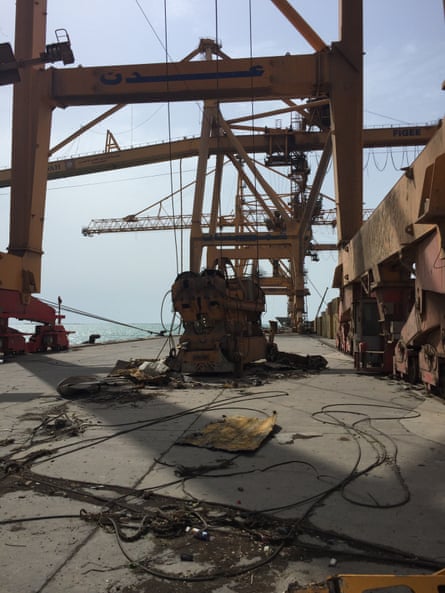People are gathered around a bed in the emergency ward of Al-Sabeen children’s hospital in Sana’a, the Yemeni capital. Five-month-old Atan is being examined while lying next to another struggling baby. He’s tiny, and his breathing is fast and shallow. His father is staring glassy-eyed while his mother holds an oxygen tube near the boy’s face. She’s wearing a niqab so all I can see are her eyes. There are no tears, but a terrible look of fear. Across the bed, a doctor frantically checks the baby over and demands urgently: “When was the last time he ate?” There is no answer.
Atan is severely malnourished. He’s been starving – as has his mother. She’s been eating so little she’s unable to breastfeed any more. She tried giving him goat’s milk, but it gave him diarrhoea.
His father, Abdul Aziz, says Atan has been like this for about a month, but the family couldn’t afford to bring him the 50km to Sana’a. It’s taken that long to scrape together and borrow the money for the trip. There is no work where they live, prices in the shops have rocketed, and Aziz is trapped farming a small plot of land that belongs to somebody else. By the time he’s paid the landowner there’s virtually nothing left to feed his family. What do you eat? I ask. “Flour. Only flour,” he says, unable to remember the last time they ate vegetables or meat.
Those who are malnourished are set to be, by far, the biggest casualties of Yemen’s war. More than 6,000 people have been killed in the bombing and fighting as a Saudi-led coalition tries to defeat the Houthi rebels and supporters of the former president, Ali Abdullah Saleh, who took over much of the country last year and drove out the new president, Abd-Rabbu Mansour Hadi.
Hundreds of thousands of children in Yemen, like Atan, are suffering from severe malnutrition, and possibly millions are in the early stages. Statistics in countries like this are unreliable, but the doctors say there is a procession of children coming through the emergency unit every day.
Patients with other conditions are made worse by malnutrition. As we stand looking at Atan, another family rushes into the ward carrying a child of around six. Within seconds doctors are doing chest compressions and blowing oxygen into his mouth but it is clearly too late. Within seconds the cries of the child’s mother fill the emergency ward. The boy had malaria but the doctor says he was so severely malnourished that he had no strength to fight the fever. About 40% of the cases coming in, he says, are made much worse by malnutrition.

To the south of rebel-held territory, lies the Red Sea port city of Hodeidah, where the vast majority of imports are brought in. Yemen is almost entirely reliant on imported food, but the port was one of the first areas to be bombed by the Saudi-led coalition. The giant cranes used to unload ships were destroyed by guided bombs. It means the only ships that can dock now are those that have their own small cranes on board. It makes the whole process painfully slow.
Food warehouses, storage silos and maintenance depots at the docks have also been hit. And beyond the port, bridges across the country have been bombed, making road transport slow and hazardous. The infrastructure Yemen needs to distribute food has been effectively crippled.
Saudi Arabia insists it does not target civilian infrastructure and said at the time it was not aiming at the civilian port but a Houthi military position. However, whether or not they are targeting civilian facilities, they are hitting them.

The port manager shows me bomb fragments gathered after the airstrikes. There are no serial numbers to check, but people here believe they are the same kind of weapons documented by Human Rights Watch that have been used against nearby factories in Hodeidah – Paveway guided bombs made in Britain and the US. Britain has sold £3bn worth of weapons to Saudi Arabia since the start of the war last year, and the Saudi airforce flies Eurofighter Typhoon jets. It is no surprise that the men working here regard Britain as a part of the coalition that is attacking them. At the numerous Houthi checkpoints across Yemen they regard us, a British filmcrew, with some suspicion.
The villages around Hodeidah are also suffering a malnutrition crisis. A mobile team of doctors and nurses provide what help they can, but they have few supplies. Parents told to take their children to hospital often can’t afford to do so.
We meet Bassam, who weighs less than when he was born several months ago. His father was a motorbike taxi driver but nobody can pay him, so he’s barely making any money. He can’t afford to travel to the city so we take the family in our car and drop them at the hospital. The UN-funded malnutrition ward in Hodeidah is crammed full of similar cases.
On our return to Sana’a we go back to the children’s hospital to catch up with the cases we had filmed before. Atan was admitted to intensive care but died two days ago, and his parents buried him in a city graveyard they now won’t be able to afford to visit.
